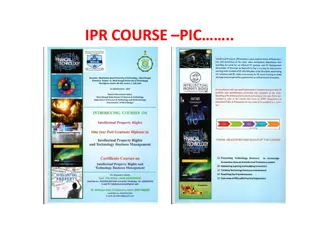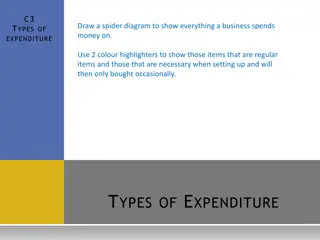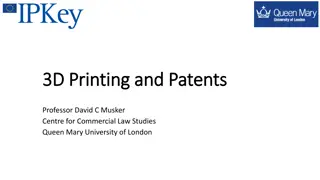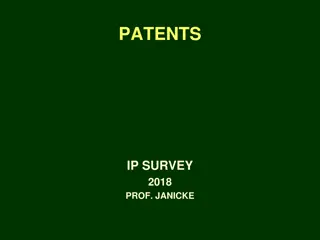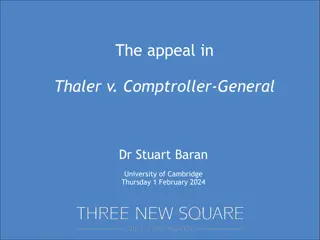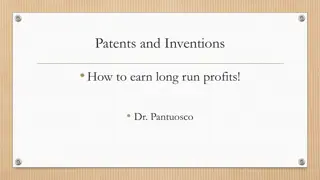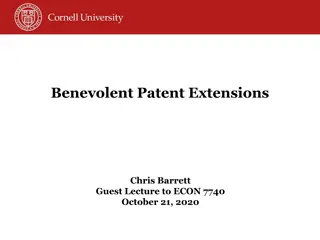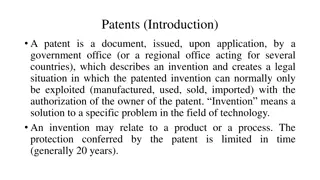
Understanding Patents: Types, Application, and Rights
Learn about patents, including types such as utility and design patents, the application process, and rights granted to inventors. Discover how patents protect inventions and designs, providing exclusive rights for a designated period. Understand the significance of patents in innovation and intellectual property protection.
Download Presentation

Please find below an Image/Link to download the presentation.
The content on the website is provided AS IS for your information and personal use only. It may not be sold, licensed, or shared on other websites without obtaining consent from the author. If you encounter any issues during the download, it is possible that the publisher has removed the file from their server.
You are allowed to download the files provided on this website for personal or commercial use, subject to the condition that they are used lawfully. All files are the property of their respective owners.
The content on the website is provided AS IS for your information and personal use only. It may not be sold, licensed, or shared on other websites without obtaining consent from the author.
E N D
Presentation Transcript
StudyMafia.Org Patents Submitted To: Submitted By: Studymafia.org Studymafia.org
Table Contents Definition Introduction Understanding Patents Types of Patents How to Apply for a Patent? Examples of Patents Conclusion 2
Definition A patent is the granting of a property right by a sovereign authority to an inventor. 3
Introduction This grant provides the inventor exclusive rights to the patented process, design, or invention for a designated period in exchange for a comprehensive disclosure of the invention. Government agencies typically handle and approve applications for patents. In the United States, the U.S. Patent and Trademark Office (USPTO), which is part of the Department of Commerce, handles applications and grants approvals. 4
Understanding Patents Most patents are valid for 20 years in the U.S. from the date the application was filed with the USPTO, although there are circumstances where exceptions are made to extend a patent's term. U.S. patents are only valid in the United States and U.S. Territories. 6
Understanding Patents If seeking protection outside of the United States, it is important to research the intellectual property rights of other nations and apply for protection with their governing authorities. 7
Types of Patents Utility Patents Utility patents, or patents for invention, issue legal protection to people who invent a new and useful process, an article of manufacture, a machine, or a composition of matter. Utility patents are the most common type of patent, with more than 90% of patents issued by the U.S. government belonging to this category. 8
Types of Patents Design Patents Design patents are patents issued for original, new, and ornamental designs for manufactured products. Design patents protect the design or look of something. They require the invention to which the design belongs to be original and useful. Design patents last for 15 years for applications filed after May 13, 2015. 9
Types of Patents Plant Patents Plant patents go to anyone who produces, discovers, and invents a new kind of plant capable of reproduction. These patents are granted for 20 years from the date of filing and no maintenance fees apply. 10
How to Apply for a Patent Before making a formal application, an applicant should research the Patent and Trademark Office's database to see if another person or institution has claimed a patent for a similar invention. The invention must be different from or an improvement upon a previous design to be considered for a patent. 11
How to Apply for a Patent Applicants need to take care to maintain accurate records of the design process and the steps taken to create the invention. Enforcing the patent is up to the person or entity that applied for the patent. To apply for a patent in the United States, the applicant submits specific documents and pays associated fees. 12
How to Apply for a Patent Written documentation includes drawings, descriptions, and claims of the item to be patented. A formal oath or declaration confirming the authenticity of the invention or improvement of an existing invention must be signed and submitted by the inventor. After fee payment, the application is reviewed and either approved or denied. 13
Examples of Patents One of the most notable patents in the past 40 years was the personal computer filed in 1980 by Steve Jobs and three other employees of Apple Inc. King C. Gillette patented the razor in 1904 and was dubbed a "safety razor." Garrett Morgan was granted a patent for the traffic light in 1923 14
Examples of Patents The patent for the television was issued in 1930 to Philo Taylor Farnsworth for the "first television system." At age 20, Farnsworth had created the first electric television image and went on to invent an early model of the electronic microscope. 15
Conclusion A patent is an exclusive right granted for an invention, which is a product or a process that provides, in general, a new way of doing something, or offers a new technical solution to a problem. To get a patent, technical information about the invention must be disclosed to the public in a patent application. 17
References Google.com Wikipedia.org Studymafia.org Slidespanda.com
Thanks To StudyMafia.org





